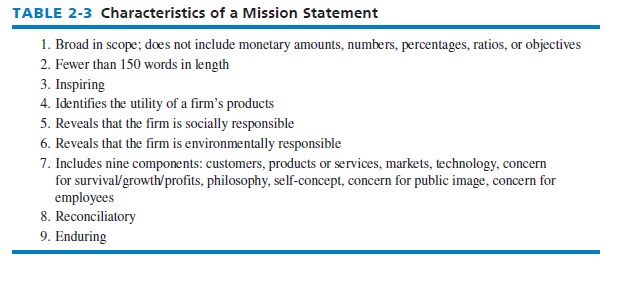A mission statement is a declaration of attitude and outlook. It usually is broad in scope for at least two major reasons. First, a good mission statement allows for the generation and consideration of a range of feasible alternative objectives and strategies without unduly stifling management creativity. Excess specificity would limit the potential of creative growth for the organization. However, an overly general statement that does not exclude any strategy alternatives could be dysfunctional. Apple Computer’s mission statement, for example, should not open the possibility for diversification into pesticides—or Ford Motor Company’s into food processing.
Second, a mission statement needs to be broad to reconcile differences effectively among, and appeal to, an organization’s diverse stakeholders, the individuals and groups of individuals who have a special stake or claim on the company. Thus, a mission statement should be reconciliatory. Stakeholders include employees, managers, stockholders, boards of directors, customers, suppliers, distributors, creditors, governments (local, state, federal, and foreign), unions, competitors, environmental groups, and the general public. Stakeholders affect and are affected by an organization’s strategies, yet the claims and concerns of diverse constituencies vary and often conflict. For example, the general public is especially interested in social responsibility, whereas stockholders are more interested in profitability. Claims on any business literally may number in the thousands, and they often include clean air, jobs, taxes, investment opportunities, career opportunities, equal employment opportunities, employee benefits, salaries, wages, clean water, and community services. All stakeholders’ claims on an organization cannot be pursued with equal emphasis. A good mission statement indicates the relative attention that an organization will devote to meeting the claims of various stakeholders.
The fine balance between specificity and generality is difficult to achieve, but it is well worth the effort. George Steiner offers the following insight on the need for a mission statement to be broad in scope:
Most business statements of mission are expressed at high levels of abstraction. Vagueness nevertheless has its virtues. Mission statements are not designed to express concrete ends, but rather to provide motivation, general direction, an image, a tone, and a philosophy to guide the enterprise. An excess of detail could prove counterproductive since concrete specification could be the base for rallying opposition. Precision might stifle creativity in the formulation of an acceptable mission or purpose. Once an aim is cast in concrete, it creates a rigidity in an organization and resists change. Vagueness leaves room for other managers to fill in the details.7
As indicated in Table 2-3, in addition to being broad in scope, an effective mission statement should not be too lengthy; recommended length is less than 150 words. An effective mission statement should arouse positive feelings and emotions about an organization; it should be inspiring in the sense that it motivates readers to action. A mission statement should be enduring. All of these are desired characteristics of a statement. An effective mission statement generates the impression that a firm is successful, has direction, and is worthy of time, support, and invest- ment—from all socioeconomic groups of people.
A business mission reflects judgments about future growth directions and strategies that are based on forward-looking external and internal analyses. The statement should provide useful criteria for selecting among alternative strategies. A clear mission statement provides a basis for generating and screening strategic options. The statement of mission should be sufficiently broad to allow judgments about the most promising growth directions and those considered less promising.

A Customer Orientation
An effective mission statement describes an organization’s purpose, customers, products or services, markets, philosophy, and basic technology. According to Vern McGinnis, a mission statement should (1) define what the organization is and what the organization aspires to be, (2) be limited enough to exclude some ventures and broad enough to allow for creative growth, (3) distinguish a given organization from all others, (4) serve as a framework for evaluating both current and prospective activities, and (5) be stated in terms sufficiently clear to be widely understood throughout the organization.8 The mission statement should reflect the anticipations of customers. Rather than developing a product and then trying to find a market, the operating philosophy of organizations should be to identify customers’ needs and then provide a product or service to fulfill those needs.
Good mission statements identify the utility of a firm’s products to its customers. This is why AT&T’s mission statement focuses on communication rather than on telephones; it is why ExxonMobil’s mission statement focuses on energy rather than on oil and gas; it is why Union Pacific’s mission statement focuses on transportation rather than on railroads; it is why Universal Studios’ mission statement focuses on entertainment rather than on movies. A major reason for developing a mission statement is to attract customers who give meaning to an organization.
The following utility statements are relevant in developing a mission statement:
Do not offer me things.
Do not offer me clothes. Offer me attractive looks.
Do not offer me shoes. Offer me comfort for my feet and the pleasure of walking.
Do not offer me a house. offer me security, comfort, and a place that is clean and happy.
Do not offer me books. Offer me hours of pleasure and the benefit of knowledge.
Do not offer me CDs. Offer me leisure and the sound of music.
Do not offer me tools. Offer me the benefits and the pleasure that come from making beautiful things.
Do not offer me furniture. Offer me comfort and the quietness of a cozy place.
Do not offer me things. Offer me ideas, emotions, ambience, feelings, and benefits.
Please, do not offer me things.
Source: David Fred, David Forest (2016), Strategic Management: A Competitive Advantage Approach, Concepts and Cases, Pearson (16th Edition).

I visited a lot of website but I believe this one contains something extra in it in it